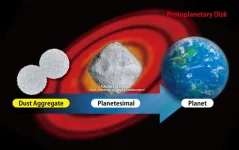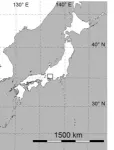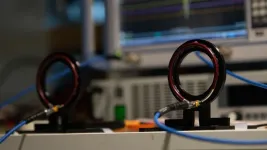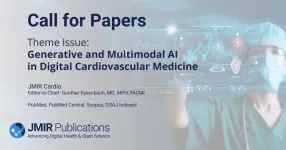(Press-News.org) Microparticle dust aggregates, which are thought to play a role in the formation of new planets, are less likely to stick together after a collision when the aggregates are larger.
Current evidence suggests that microparticles of cosmic dust collide and stick together to form larger dust aggregates that may eventually combine and develop into planets. Numerical models that accurately characterize the conditions required for colliding microparticle aggregates to stick together, rather than bounce apart, are therefore paramount to understanding the evolution of planets. Recent modeling suggests that dust aggregates are less likely to stick together after a collision as the size of the aggregates increases.
A team of astrophysicists performed numerical simulations of dust aggregate collisions, with equal-mass aggregates varying between 10,000 and 140,000 microns (one to 14 cm) in size, using soft-sphere discrete element methods. The discrete modeling system accounted for each particle within the aggregate rather than treating the aggregate as a single entity, and soft-sphere simulation assumed the rigidity of each particle of the aggregate but allowed for deformations that may occur during collision. Their modeling indicated that increasing the radius of microparticle dust aggregates decreased the sticking probability, or likelihood that two aggregates would stick together and form a larger aggregate after collision.
The team published the results of their study in The Astrophysical Journal Letters.
"The formation process of kilometer-sized bodies, planetesimals, from cosmic dust, which is the initial stage of planet formation, has been one of the biggest problems in the theory of planet formation," said Hidekazu Tanaka, one of the authors of the study and professor at the Astronomical Institute in the Graduate School of Science at Tohoku University in Sendai, Japan. "The present study showed that the dust clumps that are the material for planets stop growing when they grow to a certain size, as large clumps are difficult to adhere to each other. Our results made the problem of planetesimal formation even more difficult. The adhesive growth of dust clumps is a key process in the planet-formation process."
The simulations suggest that collisional bouncing between large microparticle aggregates would decrease the formation of planetesimals, or the building blocks of planets. Kilometer-scale planetesimals form planets through collisional merging via mutual gravity.
Earlier modeling simulations and laboratory experiments characterizing the threshold for the sticking/bouncing barrier of dust aggregate collisions often produced conflicting results, which the research team and others hypothesized was due to varying sizes of aggregates. The results of the current study support this hypothesis.
It is currently unclear why the size of aggregates affects the sticking probability during a collision. Future studies aimed at dissecting the packing structure of aggregates over time may help scientists understand how aggregates can approach the scale of planetesimals. Studies of the contact sites between aggregates, where most energy is dissipated, after a collision may also unveil how larger aggregates eventually stick together.
Additionally, the simulations performed by the research team suggest that the sticking probability of particle aggregates may also be affected by the size of the individual particles that make up the aggregate and not just the radius of the entire aggregate.
The team acknowledges that the simulations they have performed in this study are far from comprehensive. Simulations that include aggregates that can be prepared by realistic procedures and that address acceleration will be performed, and laboratory experiments that will fine-tune the model are also planned.
Beyond these simulations, the team has their sights set on larger aggregates, which may fundamentally change current theories of planet development. "We will use a supercomputer to perform large-scale numerical simulations of collisions between even larger dust clumps in order to investigate how difficult it is for large dust clumps to attach to each other. This will help to settle the question of whether the formation of planetesimals is possible through the adhesion of dust clumps or not," said Tanaka.
END
To stick or to bounce: Size determines the stickiness of cosmic dust aggregates
2023-07-21
ELSE PRESS RELEASES FROM THIS DATE:
Long-term changes in waves and storm surges have not impacted global coastlines
2023-07-21
Changes in ocean wave and storm conditions have not caused long-term impacts on sandy coastlines in the past 30 years, a new study has found.
Published today in Scientific Reports, the study draws on data from 30 years of global satellite and model studies to investigate whether changes in ocean wave conditions will have an impact on the stability of coastal environments.
The compounding effect of climate change driven variations in waves, storm surge and sea level rise is projected to lead to shoreline position change along most of the world’s sandy coasts.
A team ...
Subseasonal transition of sea-ice anomalies in the Barents–Kara Sea in winter modulated by the “warm Arctic–cold Eurasia” pattern
2023-07-21
The “warm Arctic–cold Eurasia” is one of the most significant patterns of winter climate system changes in the mid-high latitudes of the Northern Hemisphere. In winter 2020/21, this large-scale pattern underwent a significant and intense subseasonal reversal between the early and late winter. At the same time, the sea-ice anomalies in the Barents–Kara Sea changed from being significantly negative in early winter to positive in late winter. For the slow-varying process of winter sea ice, the rapid freezing ...
Miocene period fossil forest of Wataria found in Japan
2023-07-21
An exquisitely preserved fossil forest from Japan provides missing links and helps reconstruct a whole Eurasia plant from the late Miocene epoch.
Complete plant fossils are seldom found as a single piece, as wood, leaves, flowers, fruits, seeds, or pollen detach easily from plants. This results in leaves and trunks having separate scientific names. Putting together the different parts to reveal the complete plant is like putting together a jigsaw puzzle. Connecting these dots and reconstructing plants is important to establish their taxonomic identity—their ...
Going the distance for better wireless charging
2023-07-21
A better way to wirelessly charge over long distances has been developed at Aalto University. Engineers have optimized the way antennas transmitting and receiving power interact with each other, making use of the phenomenon of “radiation suppression”. The result is a better theoretical understanding of wireless power transfer compared to the conventional inductive approach, a significant advancement in the field.
Charging over short distances, such as through induction pads, uses magnetic near fields to transfer power with high efficiency, but at longer distances the efficiency dramatically drops. New research shows that this high efficiency ...
Are shared medical appointments the key to solving global healthcare shortages?
2023-07-21
This research was conducted by Nazlı Sönmez, ESMT Berlin; Kavitha Srinivasan and Rengaraj Venkatesh, Aravind Eye Hospital (India); Ryan W. Buell, Harvard Business School; and Kamalini Ramdas, London Business School. The researchers wanted to understand the impact of shared medical appointments on patient experience (knowledge gained and satisfaction) and behavior (follow-up rates and medication compliance rates).
In shared medical appointments (SMAs), patients with the same medical condition meet with the physician in a group, with each patient receiving attention in turn. The physician shares information customized to a patient’s specific needs as well ...
HKUMed finds metformin could promote healthy ageing based on genetics
2023-07-21
A research team from the School of Public Health, LKS Faculty of Medicine of the University of Hong Kong (HKUMed), provides genetic evidence that metformin might promote healthy ageing using a cohort study of more than 300,000 participants of European descent (UK Biobank). This proof-of-concept work supports further clinical research into the drug repositioning of metformin in healthy longevity. The findings are now published in The Lancet Healthy Longevity, a leading peer-reviewed, international journal in the field of geriatrics and gerontology [link to the publication].
Background
Metformin is a first-line medication for type 2 diabetes. ...
Important update on use of trabecular bone score (TBS) in clinical practice
2023-07-21
A new position paper presents an up-to-date review and expert recommendations using the GRADE methodology to inform the implementation of trabecular bone score (TBS)* in clinical practice for the management of primary and secondary osteoporosis.1
TBS is a grey-level scale textural measurement acquired from dual-energy X-ray absorptiometry lumbar spine images that correlates with bone microarchitecture and which can be used alongside FRAX and bone mineral density measurements to enhance the assessment of fracture risk and to inform treatment initiation and monitoring.
The position paper was authored by an international ...
Call for papers theme issue on generative and multimodal artificial intelligence (AI) in digital cardiovascular medicine
2023-07-21
JMIR Cardio Editor-in-Chief: Gunther Eysenbach, MD, MPH, FACMI welcomes submissions to a special theme issue examining "Generative and Multimodal Artificial Intelligence (AI) in Digital Cardiovascular Medicine."
This call for papers aims to explore the potential of generative AI in health care and medicine, specifically in the field of cardiovascular medicine and its subspecialties. This includes, but is not necessarily limited only to, large language models and multimodal AI that can be applied to electrophysiology, congenital heart diseases, transplant cardiology, ...
Probiotic combo stops bacteria that cause toxic shock syndrome
2023-07-21
Highlights:
Toxic shock syndrome (TSS) is a rapid-onset, life-threatening disease associated with strains of Staphylococcus aureus.
New findings published in Microbiology Spectrum suggest that a probiotic combination could reduce incidence of TSS.
In lab experiments, the probiotics reduced production of the superantigen that causes TSS.
The researchers say a probiotic approach may also help people who suffer from other staph infections, including those with atopic dermatitis or type 2 diabetes.
Washington, D.C. – The widespread, pathogenic microbe Staphylococcus aureus can colonize the skin and mucous membranes throughout the body, particularly the vagina ...
Brigham researchers reverse chemotherapy-related fertility loss using cell-based therapy
2023-07-21
The preclinical study showed that injecting ovarian tissue-derived differentiated induced pluripotent stem cells can restore hormone production and fertility in mice with premature ovarian failure related to genetic diseases and cancer treatment
A new study by investigators from Brigham and Women’s Hospital, a founding members of the Mass General Brigham healthcare system, in a preclinical model demonstrates the potential for restoring fertility when the ovaries have stopped working. Researchers found that adult stem cells could restore healthy hormone levels after chemotherapy and lead to natural conception resulting in the birth of live mice. Techniques based on the study could revolutionize fertility ...







